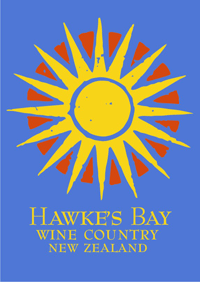Hawkes Bay Syrah Tastings

Hawkes Bay is located on the eastern coast of the North Island and experiences some of the highest heat accumulation in the country. Hawkes Bay’s climate has been described as almost perfect for growing Syrah, and the Hawkes Bay Winegrowers Inc describe syrah as “the most exciting wine produced in the Hawkes Bay”. Hawkes Bay has a total winegrowing area of 4947ha, of which 34% is Syrah, making up 86% on New Zealand’s total syrah production.
Craggy Range Gimblett Gravels Syrah 2009
This wine was as clean cut as they come, reminiscent of an over-produced mass-market wine, it had little if any ‘character’ but was pleasant to drink. The traditional black pepper aroma of Syrah’s from Hawkes Bay was reduce to a hint of spice and fruit flavours were vinous and a touch green. This is indicative of a poor year, with fruit lacking concentration and having unripe phenolics. Craggy Range report that 2009 was close to a complete disaster with moderate temperatures and high rainfall leading to high disease pressure and inconsistent berry development.
Brookfields Hillside Syrah 2009
Grown on a north facing slope this syrah seemed to have not suffered the same lack of intensity as the Craggy Range syrah, although slight vegetative and bitter notes of the finish are indicative of a poor season. The concentration of flavour and complex array of character made this wine an excellent example of what Hawkes Bay can produce, even in poor vintages. Brookfields maintain low volumes so they can focus on high quality over quantity and it shows in the care with which this wine has been made.
Te Awa Syrah 2010
This wine had a huge hole in the mid palate, which indicates to me that complexity and finesse have been forsaken in favour of upfront fruit flavours to appeal to the mass market. With little or no structure and a complete lack of character this wine is unlikely to age elegantly making the $35 price tag rather steep for a drink-now wine. Sulphur and mercaptans on the nose are indicative of an oxidative winemaking style applied without sufficient attention to detail. Perhaps this is because Ant McKenzie leaves the Syrah for long periods in barrel without sulphur.
Trinity Hill Syrah 2010
This quintessential Hawkes Bay syrah has all the right indicators of a quality producer – intense aromatics, complex flavours and a robust structure make this wine a great candidate for 3-6 years careful cellaring. Sadly this wine is still a little closed, with primary and secondary fruit character only just beginning to open up and develop tertiary characters. After 20 minutes in the glass a touch of parma ham on the nose gave hints at this wine’s potential. This wine is blended with a small amount of Viognier for added aromatic complexity and this shows on the nose.
Ngatarawa Glazebrook Syrah 2010
This wine was elegant and easy to drink but lacked a bit of concentration and primary fruit character. Peter mentioned that 2010 had very high disease pressure due to high humidity and rainfall during the growing season. This may be why the wine lacked primary fruit flavours and savoury tertiary characters dominated. I’m a big fan of Ngatarawa wines but this wine was an exception, but for the price it was still a pleasing drink.
Te Mata Estate Woodthorpe Syrah 2010
This wine was exceptionally easy drinking. Harsh phenolics and bitterness had been toned down to ‘consumer’ levels, and primary fruit flavours were rich and tasty. This wine was paler than the others, which indicates that maceration was limited to just enough for colour stability. Given the low phenolics and lack of the classic black pepper notes this wine was likely racked soon after fermentation with minimal lees contact and post ferment maceration. I would also hazard a guess that heavy handed fining/filtering was utilised to keep this wine clean and easy to drink.
Overall Impressions
The wines in this flight had a number of commonalities, such as peppery notes on the nose and rich dark fruit flavours, however there was enough variation to demonstrate that Hawkes Bay could make a range of styles successfully. It is more common in new world regions for a range of styles of wine to be made (because a dominant popular style has not yet emerged like it has with Marlborough Sauvignon Blanc), leading to conflicting messages to consumers. As such, this may be why syrah has not (yet) taken off in Hawkes Bay as much as could be expected given the ample potential of the region.
Related Posts
Categories: Varietals Wine Reviews Wine Tasting
